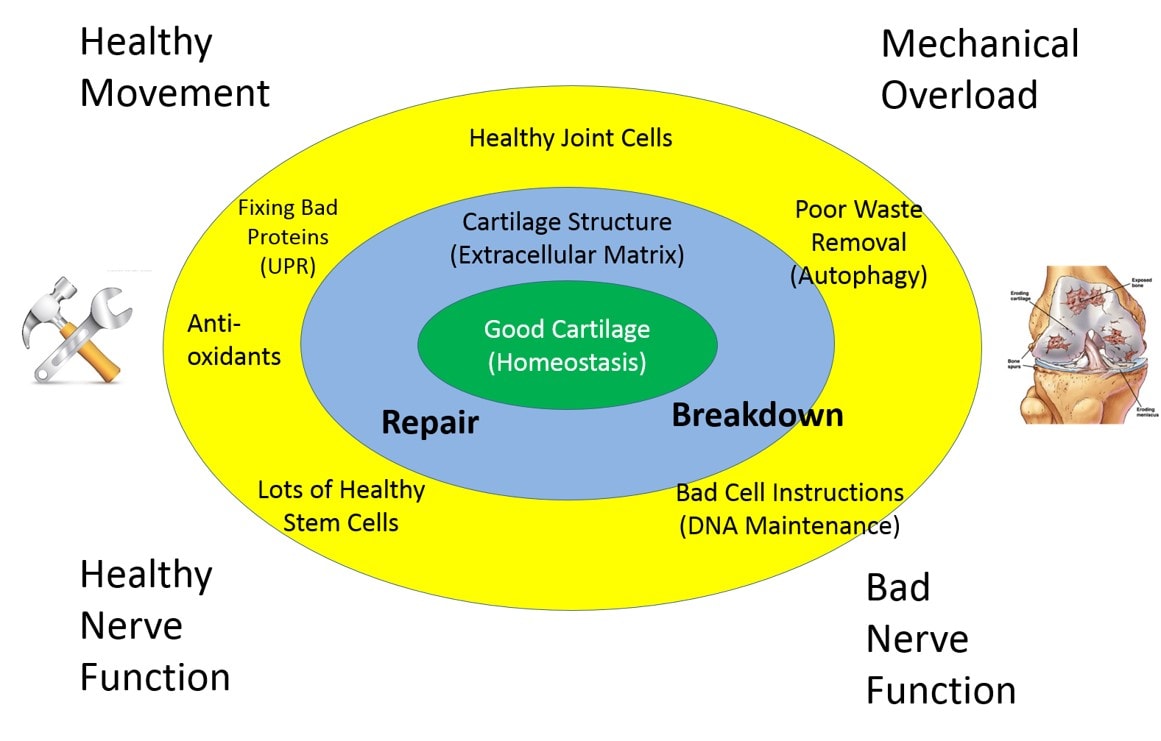What is Arthritis and How Can Your Stem Cells Help Arthritis?
What is arthritis and how can your stem cells help arthritis? Arthritis is a complex problem involving stem cells and a host of other problems. I recently came across a good illustration in a research paper, the problem was that it was steeped in scientific jargon. I sat down and recreated it so that it could be more easily understood and I’d like to share it with you. This will give you a glimpse into the world of arthritis researchers and how stem cells fit into the equation.
Above you see the green center circle called “Good Cartilage”. The official medical word is homeostasis, or literally in Latin, “staying the same while standing still”. This is a unique property of a healthy body or organ, in that it can maintain itself in good repair. In the next ring out (blue) you see the constant processes of breakdown balanced by repair. You are constantly hurting your cartilage as you run, walk, pivot, or just bend your knee. That normal breakdown has to be “fixed” by repair. Everyday any number of seemingly invisible processes happen to rebuild what’s been damaged. In addition, opposing the breakdown of normal cartilage is the robustness of the cartilage itself. Stronger cartilage won’t break down as fast.
The blue ring above breaks our diagram into two sides, off to the left we have things that repair the cartilage structure and off to the right we have things that break it down. Really any system in the yellow ring, if it were to go wrong, could potentially hurt the cartilage, but this is how the researcher arranged this diagram to support the text so I kept it this way. In the yellow ring you see all the processes that must be humming at high efficiency to keep the cartilage structure sound or to repair it. Starting at the top 12 o’clock position you see healthy joint cells. The medical term for these are chondrocytes. These cells make up cartilage and have to be healthy for cartilage to be able to maintain itself. Moving clockwise, you then see “Poor Autophagy”. We learned about this cell garbage man function a few days ago. This is a process whereby the cell removes it’s own broken parts and waste. Then we see “Bad Cell Instructions”. The DNA and RNA in a cell are the blueprint plans for life and in this case, they can tell the cell how to make which proteins and other things to help it live. If these instructions get damaged, then the cell doesn’t know what to make. At the 7 o’clock position we see “Lots of Healthy Stem Cells”. Stem cells are the repairmen of the joint. When a cartilage cell dies off, a stem cell can turn itself into a new cartilage cell to fill the hole. In addition, stem cells act as construction managers that help other cells repair damage to the cartilage structure. As you age, the number of these tiny stem cell repairmen decreases, thus reducing your joint’s ability to repair itself. This is why we supplement stem cells in arthritic joints. At the 9 o’clock position is “Anti-oxidants”. Oxidative stress is where certain molecules needed by the cell become oxidized (think rust). Fruits and vegetables are rich sources of anti-oxidants. Common supplement anti-oxidants include Vitamin A, C, E, Beta-carotene, and Selenium. Be careful with taking high doses of these, as some accumulate in the body and at high doses may actually cause more oxidation! Next up is “Fixing Bad Proteins” or otherwise known as UPR. This is a system inside your cells that allows bad proteins that may be made by damaged DNA or other stresses to be eliminated or if the proteins are consistently messed up, allows the cell to throw up a flag for self-destruction (apoptosis). The UPR system is actually hurt by metabolic syndrome and obesity, such that the proteins that make up the structure of the cartilage get weak. Essentially because of the added stress, the protein quality assurance workers go on strike, allowing loads of bad proteins through which end up being like bad parts in a factory.
Note that outside the circle, I have placed some of the Orthopedics 2.0 concepts, namely that bad bio mechanics and nerves are also very much responsible for unhealthy joints. To learn more about these, read our practice’s e-book, Orthopedics 2.0. Basically, bad bio mechanics add to the wear and tear of a joint and bad nerves cause more breakdown chemicals to be released into the joint.
The upshot? Why cartilage breaks down is complex! However, a few simple things like cleaning up your diet, getting better insulin control, and adding stem cells may help move the balance from breakdown towards repair. In addition, making sure that your bio mechanics are optimized (take the self-tests in the orthopedics 2.0 book) and that your nerves are working well, are other areas to check.

If you have questions or comments about this blog post, please email us at [email protected]
NOTE: This blog post provides general information to help the reader better understand regenerative medicine, musculoskeletal health, and related subjects. All content provided in this blog, website, or any linked materials, including text, graphics, images, patient profiles, outcomes, and information, are not intended and should not be considered or used as a substitute for medical advice, diagnosis, or treatment. Please always consult with a professional and certified healthcare provider to discuss if a treatment is right for you.

